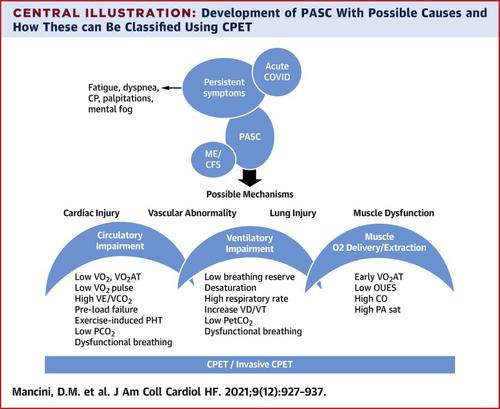JACC: Heart Failure ( IF 10.3 ) Pub Date : 2021-11-29 , DOI: 10.1016/j.jchf.2021.10.002 Donna M Mancini 1 , Danielle L Brunjes 2 , Anuradha Lala 1 , Maria Giovanna Trivieri 2 , Johanna P Contreras 2 , Benjamin H Natelson 3

|
Objectives
The authors used cardiopulmonary exercise testing (CPET) to define unexplained dyspnea in patients with post-acute sequelae of severe acute respiratory syndrome-coronavirus-2 (SARS-CoV-2) infection (PASC). We assessed participants for criteria to diagnose myalgic encephalomyelitis/chronic fatigue syndrome (ME/CFS).
Background
Approximately 20% of patients who recover from coronavirus disease (COVID) remain symptomatic. This syndrome is named PASC. Its etiology is unclear. Dyspnea is a frequent symptom.
Methods
The authors performed CPET and symptom assessment for ME/CFS in 41 patients with PASC 8.9 ± 3.3 months after COVID. All patients had normal pulmonary function tests, chest X-ray, and chest computed tomography scans. Peak oxygen consumption (peak VO2), slope of minute ventilation to CO2 production (VE/VCO2 slope), and end tidal pressure of CO2 (PetCO2) were measured. Ventilatory patterns were reviewed with dysfunctional breathing defined as rapid erratic breathing.
Results
Eighteen men and 23 women (average age: 45 ± 13 years) were studied. Left ventricular ejection fraction was 59% ± 9%. Peak VO2 averaged 20.3 ± 7 mL/kg/min (77% ± 21% predicted VO2). VE/VCO2 slope was 30 ± 7. PetCO2 at rest was 33.5 ± 4.5 mm Hg. Twenty-four patients (58.5%) had a peak VO2 <80% predicted. All patients with peak VO2 <80% had a circulatory limitation to exercise. Fifteen of 17 patients with normal peak VO2 had ventilatory abnormalities including peak respiratory rate >55 (n = 3) or dysfunctional breathing (n = 12). For the whole cohort, 88% of patients (n = 36) had ventilatory abnormalities with dysfunctional breathing (n = 26), increased VE/VCO2 (n = 17), and/or hypocapnia PetCO2 <35 (n = 25). Nineteen patients (46%) met criteria for ME/CFS.
Conclusions
Circulatory impairment, abnormal ventilatory pattern, and ME/CFS are common in patients with PASC. The dysfunctional breathing, resting hypocapnia, and ME/CFS may contribute to symptoms. CPET is a valuable tool to assess these patients.
中文翻译:

对冠状病毒感染后不明原因呼吸困难患者进行心肺压力测试
目标
作者使用心肺运动测试 (CPET) 来定义严重急性呼吸综合征冠状病毒 2 (SARS-CoV-2) 感染 (PASC) 急性后遗症患者的不明原因呼吸困难。我们评估了参与者的诊断肌痛性脑脊髓炎/慢性疲劳综合征 (ME/CFS) 的标准。
背景
大约 20% 从冠状病毒病 (COVID) 中康复的患者仍有症状。这种综合征被命名为 PASC。其病因尚不清楚。呼吸困难是一种常见的症状。
方法
作者在 COVID 后 8.9 ± 3.3 个月对 41 名 PASC 患者进行了 CPET 和 ME/CFS 症状评估。所有患者的肺功能检查、胸部 X 线检查和胸部计算机断层扫描均正常。测量了峰值耗氧量(峰值VO 2)、每分钟通气量与CO 2产生的斜率(VE/VCO 2斜率)和CO 2的潮气末压力(PetCO 2)。通气模式被定义为快速不规则呼吸的功能失调性呼吸。
结果
研究了 18 名男性和 23 名女性(平均年龄:45 ± 13 岁)。左心室射血分数为 59% ± 9%。峰值 VO 2平均为 20.3 ± 7 mL/kg/min(预测的 VO 2为 77% ± 21% )。VE/VCO 2斜率为 30 ± 7。静止时的 PetCO 2为 33.5 ± 4.5 mm Hg。24 名患者 (58.5%) 的峰值 VO 2 <80% 的预测值。VO 2 <80%峰值的所有患者 都存在运动循环受限。17 名 VO 2峰值正常的患者中有 15名有通气异常,包括峰值呼吸频率 >55 (n = 3) 或呼吸功能障碍 (n = 12)。在整个队列中,88% 的患者 (n = 36) 出现通气异常并伴有呼吸功能障碍 (n = 26)、VE/VCO 2升高(n = 17) 和/或低碳酸血症 PetCO 2 <35 (n = 25) . 19 名患者 (46%) 符合 ME/CFS 标准。
结论
循环障碍、异常通气模式和 ME/CFS 在 PASC 患者中很常见。呼吸功能障碍、静息低碳酸血症和 ME/CFS 可能导致症状。CPET 是评估这些患者的宝贵工具。











































 京公网安备 11010802027423号
京公网安备 11010802027423号